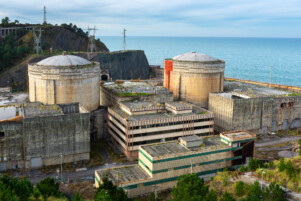A nuclear power station in New Zealand seems far-fetched. But the idea was touted, and in a location near here. Wairarapa Archive’s MARK PACEY digs into the proposed Palliser nuclear power station.
The construction of a nuclear power station in New Zealand seems to be the stuff of movies. But the idea was seriously considered in the 1970s. At that stage, it wasn’t a priority as the energy needs were being met, but anticipated population and industry growth meant that the power needs would also increase, and more energy would be required.
Even before New Zealand became nuclear-free, there was a strong anti-nuclear sentiment in the country. Several reports were commissioned in the decade of the 70s, and while they were all against nuclear power at the time, they had to admit that the need for nuclear power in the future was an option. A report by the Royal Commission of Inquiry had this to say:
“The chances of New Zealand needing nuclear power for electricity generation early in the next century are real indeed, and a significant nuclear programme should then be economically possible if a similar relationship to that which in the past has existed between economic and electricity growths is maintained”.

Public opinion was sought and in 1975 a postal survey was sent to 17,500 New Zealand households with a 58.8 per cent response rate. In the survey, households were asked:
“A new power plant is planned in your area. A coal plant [a] and a nuclear plant [b] would produce power for roughly the same cost, but the coal plant would cause air pollution and there could be problems with disposing of the radioactive nuclear wastes” An oil plant was also a part of the same scenario.
The results were interesting. Coal still won with 45 per cent of the votes, but nuclear power still had 24 per cent approval. Despite it being touted as a “clean, cheap, limitless source of energy” most people still preferred coal, even though its air pollution was far higher.
The big question was, if we were to have a nuclear power plant, where would we build it?
In July 1974, the Electricity Department conducted a survey of New Zealand for a site for a nuclear power station. While they weren’t committing publicly to the building of a nuclear power station, they were keeping their options open for the future. If they determined a suitable site, then they would have it ready for when they would come to build it when the energy needs of the country changed.
A small article appeared in the Times-Age on July 2, 1974. Titled “No decision yet on site for nuclear power station” it went into a little bit of detail of some of the areas being considered. In 1974, nuclear power was still relatively untarnished. Three Mile Island wouldn’t happen for another five years, and Chernobyl was more than a decade away, so fear of accidents wasn’t realised yet.
So, when in the same article it was stated “Lately it [Electricity Department] had been making seismic surveys in the Cape Palliser region in search of possible sites in South Wairarapa”, there would have been some concern, but no real fear yet of a nuclear disaster.
Palliser Bay made some sense as a location for a nuclear power station. It was close to the capital, centrally located, and if something did happen, it wasn’t located in a bustling city but in a more sparsely populated area.
But support for a nuclear power station never really got off the ground. The public were against the idea, the officials were too. They saw no need for one and after Three Mile Island the support dropped even more. If it could happen in America then it could certainly happen here, and did we really want a nuclear meltdown on the Wairarapa Coast?
In 1987, the year after the Chernobyl disaster, New Zealand became officially nuclear-free, and any lingering support for a nuclear power station in Palliser of anywhere else was scuttled.



This better never happen we don’t need all this shit sit down have a cup of tea and enjoy what we have the government is destroying everything to try compete with the world it’s discusting just stop the growth and get what we have right
Placing a nuclear plant actually ON a major fault line (the 1855 quake raised sections of the Palliser foreshore significantly), and close to the Trough just offshore to the east was indeed a strange option.
I am in FAVOUR of nuclear power. The plant design of today is hugely different to that of Chernobyl (or Three Mile Island) and there are options such as Thorium which is cheaper than uranium and which also can burn disposed uranium as a part of the fuel. The end product has a much shorter half-life (hundreds of years compared to thousands of years). Auckland creates the largest demand – so build the plant close to the demand. This not only reduces transmission costs but Wellington is a population static region.
Too much “fear” about nuclear power.
Nuclear Free Zone.N.Z.Aotearoa.
Time to renew the concept of Nuclear Pwr Generation in Nz. The average build time is 7yrs. Whilst further wind & solar power will be able to usefully contribute to demand the question is how to future proof supply. Reticulation is another seperate supply issue. Global warming has & will continue to cause variable weather anomalies making reliance on traditional generation more risky & even internittent notwithstanding increasing consumption elements. Nuclear will stabilise those supply concerns providing we act now.